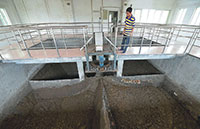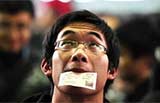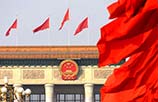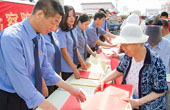Ancient travels offer historical treasure
By Erik Nilsson (China Daily) Updated: 2015-12-07 08:32Near the hall is a scale replica of Zheng's ship that displays smaller models of his vessels inside. The concept resembles a ship in a bottle — just replace the bottle with a larger ship.
Another ship replica rises from the water at the 100-hectare Zheng He Memorial Park in Jiangsu's Suzhou city. It floats next to a statue of the explorer that is 18 meters high — because he was 1.8 meters tall — on a pedestal that is 2.8 meters high, since his voyages spanned 28 years.
The statue's countenance appears fierce, as Zheng was an imposing personality. It is said that he "walked like a tiger" and spoke with "the clamor of thunderous bells".
The Zheng He Memorial Hall's Tunnel of Time depicts the evolution of China's nautical excursions. There are also facsimiles of the goods he traded — porcelain, tea and a Nanjing brocade adorned with a dragon and phoenix. And there are copies of treasures he brought back — fragrances, precious stones and a rhino horn.
From East Africa's Swahili Coast alone, Zheng's ark carried such exotic creatures as zebras, camels and ostriches, not to mention ivory.
The giraffe he brought from Kenya was revered as a totem of the empire because of its resemblance to the qilin, a mythical Chinese beast believed to herald the arrival or death of a great sage.
Zheng was a devout Muslim, but Mazu, also known as Tianfei or Lin Mo, was the deity to which he was most devoted.
He would make sacrifices at the Tianfei Palace in Suzhou's Taicang city, as crews loaded his ships. (Zheng would pack his vessels in Taicang, since the city was a granary, and then head to Fujian's Quanzhou harbor to wait for welcoming winds to set off.)
A temple, first built in 1123, during the Song Dynasty (960-1279) was reconstructed in 1342, during the Yuan Dynasty (1271-1368). It resumed official functions as a Taoist holy site in 2009 and was listed for national preservation in 2013.
Legend claims Tianfei answered Zheng's prayer during a tempest off Malacca and sent a magic lantern to illuminate the inky skies. Zheng then tricked and captured a Chinese pirate who had been controlling the Strait of Malacca.
The temple is nestled in a traditional community, where white-walled Jiangsu-styled residences are laced with cobbled streets and canals.
People can visit the port from which Zheng set off — a blade of bald land near today's Taicang Port, one of China's busiest.
For centuries, until China's opening-up and reform, Taicang was a more important commercial hub than Shanghai. The ships that bob in its waters nod to Zheng's legacy of Chinese trade at sea. Their journeys are postscripts to his epic story.
Contact the writer through erik_nilsson@chinadaily.com.cn
- Hundreds of fugitives are brought back since April
- New steps will simplify driving training and tests
- Capital opens door to hukou applicants
- Nobel Prize 'to spur TCM development'
- Beijing lifts red alert but smog will be back in two days
- Psychiatrist links smog, depression
- Weather a bonanza for taxi services
- Lawyer: Top court OKs death sentence in poisoning case
- Power for ministries to be clarified
- Red alert helps to reduce pollutants, say experts







